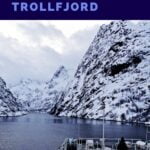Tucked between the towering peaks of the Lofoten Islands, the Trollfjord is a dramatic, narrow fjord renowned for its breathtaking beauty. Here’s everything you need to know about this natural wonder in Northern Norway.
As our ship slipped silently between towering cliffs, the entrance to Trollfjord felt like something out of a fantasy novel. It was so narrow, so still, and so impossibly dramatic that the entire deck fell quiet.
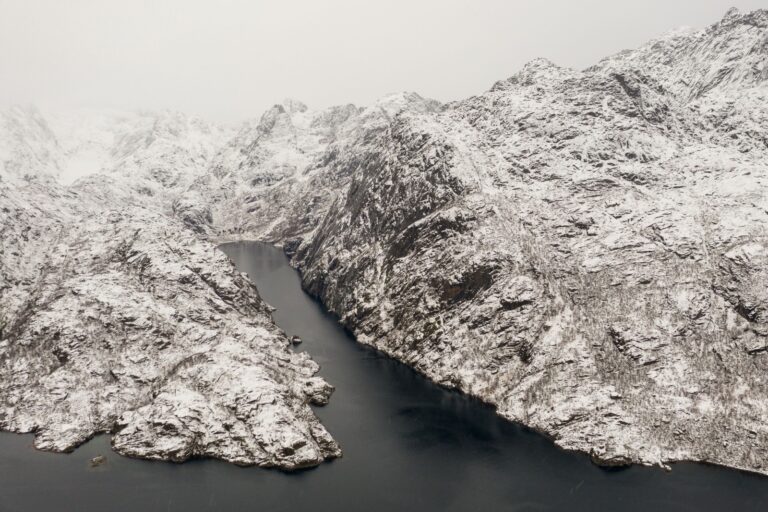
The Trollfjord is a completely unspoilt fjord in the north of Norway. Its natural environment makes it a thriving habitat for various species of birds and sea life. The fjord also has a fascinating history, with many tales to tell.
Accessible only by boat, the fjord's steep cliffs rise sharply from the water, creating an awe-inspiring natural spectacle that has become a must-see destination for Arctic explorers and nature enthusiasts.
If you have at least some casual knowledge of the Norwegian outdoors, you’ve most likely heard of the Sognefjord, Lysefjord and the world-famous Geirangerfjord.
But how about a much smaller fjord located far away from the World Heritage listed west Norwegian fjords? All the way up in Northern Norway, in fact?
Tucked away in the far north somewhere between Lofoten and Vesterålen is the spectacular, narrow Trollfjord. It’s a fjord full of natural beauty, wonder and it also has an interesting history.
Let’s take a look at northern Norway’s hidden gem of a fjord, undoubtedly one of the best fjords in Norway.
What Makes the Trollfjord Unique?
The most famous Norwegian fjords can be found along the west coast of Norway. So much so, that this region is often nicknamed ‘Fjord Norway' in tourist material. The Trollfjord is a little different because it's located in Northern Norway, north of the Arctic circle.
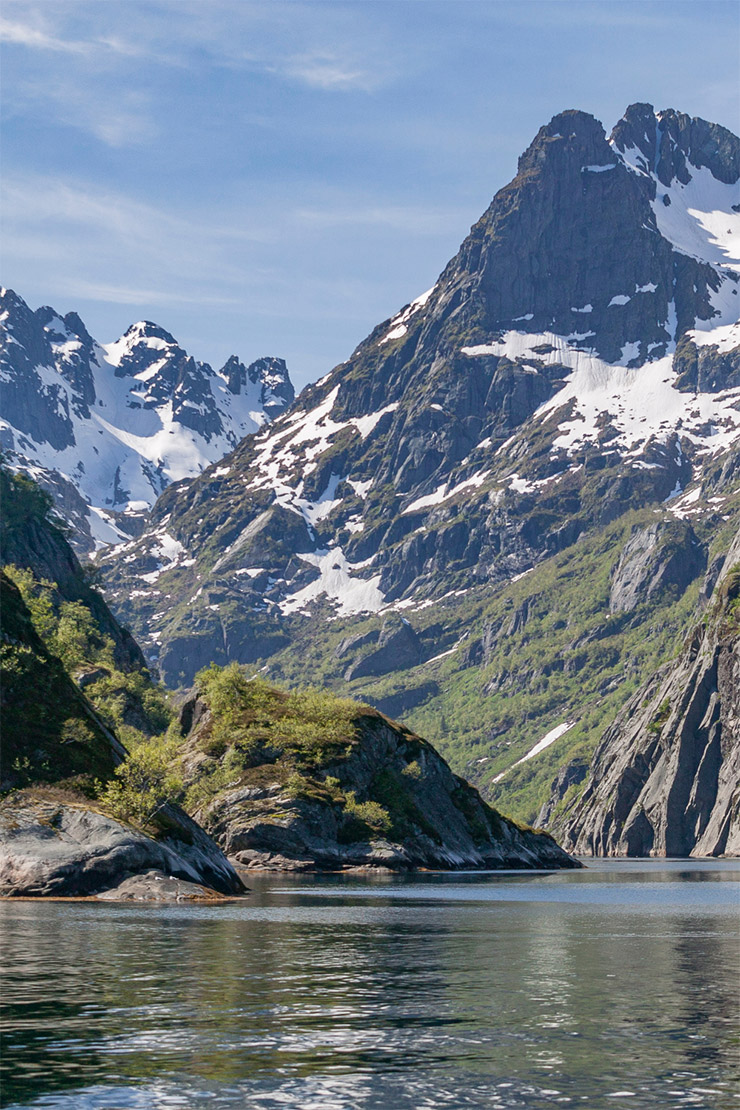
The Trollfjord is also an unspoilt, natural wonder. Unlike many popular fjords up and down Norway, there are no settlements along its banks. As such, it’s only accessible by boat.
It’s also tiny in comparison with other famous fjords, but that doesn’t take anything away from what it offer tourists. Famous tourists, too.
German Emperor Wilhelm II first visited Lofoten in 1889 after being inspired by paintings at a Berlin art exhibition. He returned several times, and his visits likely sparked tourism to Lofoten. The Trollfjord also featured in the 2016 film Downsizing starring Matt Damon.
By the way, the name comes from the legend of trolls Vågakallen and Hinnøygubben, who fought over pasture at Trollsjøen in Raftsundet. After several quarrels, Hinnøygubben fell and struck his ax in the ridge, creating this stunning fjord.
Where is the Trollfjord?
The fjord is set between Lofoten and Vesterålen, northern islands that experience mild summers and wet winters.
While fjords are known for stretching far inland from their mouth (entrance or start point), the Trollfjord is much smaller. At just 2km (1.2 miles) long, it’s one of the smaller fjords in Norway.
Trollfjord is also one of the narrowest fjords. This means that as you enter by boat, it'll feel as if you can almost touch the mountains to the sides. At its narrowest point, the fjord has a width of just 100 metres (328 feet).
Despite (or more accurately, because of) the fjord being so small, it has dramatic and stunning views along its length. Steep cliff faces reach 1,100 metres (3608 feet) into the sky at their highest point.
They're green in the warmer months but snow-covered in the winter. Unfortunately, this beauty means the fjord is generally inaccessible during winter. The risks of snow fall and avalanches are just too great.
The Battle of Trollfjord
On 6 March 1890, the otherwise peaceful waters of the Trollfjord became the stage for a dramatic and symbolic confrontation that came to be known as the Battle of Trollfjord (read more here in Norwegian).
At the heart of the conflict was a growing tension between tradition and modernity. For centuries, local fishermen in the Lofoten Islands had relied on open rowing boats to access the seasonal cod fisheries that gathered near the fjord’s mouth.
But by the late 19th century, technological change was reshaping the industry. Steam-powered fishing vessels, larger and faster, began arriving in increasing numbers, threatening the livelihood of the traditional rowboat fishermen.
During the height of the cod season in 1890, the owners of the industrial vessels attempted to monopolise the bounty of the fjord by dragging a rope across the mouth of the Trollfjord to block smaller boats from entering.
In response, hundreds of local fishermen in open boats mounted a rebellion, cutting the ropes and forcing their way into the fjord in a tense and sometimes violent clash.
Although no one was killed, the confrontation became a powerful symbol of resistance against industrialisation and the loss of traditional ways of life. The event sparked national debate in Norway about fairness, access to natural resources, and the growing divide between rich and poor.

The scene was immortalised by the Norwegian painter Gunnar Berg (1863–1893) in his dramatic work The Battle at Trollfjord, painted shortly after the incident. With its sweeping brushstrokes and almost theatrical energy, the painting captures the chaos, defiance, and raw human emotion of the moment.
Today, it remains one of Norway’s most iconic artworks and is on display at the Gunnar Berg Gallery in Svolvær, the artist’s hometown.
The legacy of the event also lives on in literature. Johan Bojer’s 1921 novel The Last of the Vikings (Den siste viking) draws inspiration from these same tensions, offering a gripping portrayal of life in the Lofoten fisheries during a time of great change.
When Is the Best Time to Visit the Trollfjord?
The best time to visit Trollfjord is during the summer months, typically from May to early September, when the weather is milder, days are long, and the fjord is safely accessible by boat. This is also when most sightseeing tours run.
Outside of this season, especially in winter, snow and avalanche risks make entering the fjord dangerous, and most excursions are suspended.
Tip! How much you'll enjoy your trip to Norway depends very much on the time of year you choose. Check our my guide on when to visit Norway.
Trollfjord Sightseeing Tours
Since the Trollfjord is only accessible by sea, the only way to experience its dramatic scenery is by boat.
Fortunately, there are plenty of sightseeing tours departing from Svolvær, the nearest town. These trips typically last around three hours and start from approximately NOK 1,200 per person.
Tour options vary by season and operator. Some cruises are on modern sightseeing boats with indoor lounges and outdoor decks, while others use fast RIB boats (rigid inflatable boats) for a more adventurous experience. Depending on the company, refreshments may be included or available to purchase on board.
If you're travelling along the Norwegian coast on a Hurtigruten or Havila Voyages ship, you may be treated to a sail into the Trollfjord as part of the itinerary. Both companies operate year-round services and, during the summer months, their ships often make a slow detour into the fjord, weather and light conditions permitting.
It's one of the most memorable moments of the voyage, as passengers gather on deck to admire the towering cliffs and narrow channel.
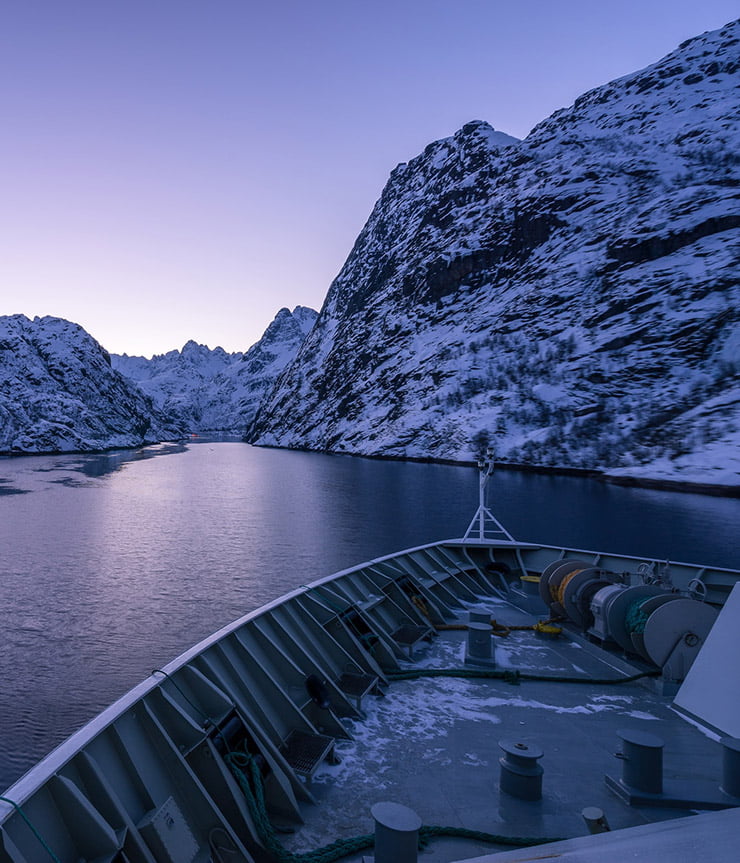
In the winter months, when access to the Trollfjord is limited due to snow and avalanche risk, Svolvær becomes a hub for whale-watching tours instead.
These excursions focus primarily on Orcas (killer whales) and humpback whales, which follow the herring into the waters of Northern Norway during the dark and dramatic Arctic winter.
Birdwatching and Wildlife
The Trollfjord and its surroundings are unaffected by human interference, which makes for perfect birdwatching conditions.
So if entering the majestic fjord itself isn’t quite enough for you, then catching sight of the white-tailed eagles that soar overhead will certainly make your day.
In addition to the feathered variety of wildlife, you might also see various species of whales, porpoises, basking sharks and seals in the water. And if you’re really lucky, maybe even Atlantic white sided/beaked dolphins too.
There are many local fishing trips that offer opportunities to catch cod, pollock, haddock and mackerel. In addition, it’s also possible to catch herring, redfish, catfish, monkfish, flounder and halibut.
Where to Stay by the Trollfjord
If you're planning a visit to the Trollfjord, the best base by far is the town of Svolvær, the unofficial capital of Lofoten.
Located on the southern coast of Austvågøya, Svolvær offers a mix of urban convenience and dramatic natural scenery, with easy access to sightseeing cruises, wildlife tours, and other island adventures.
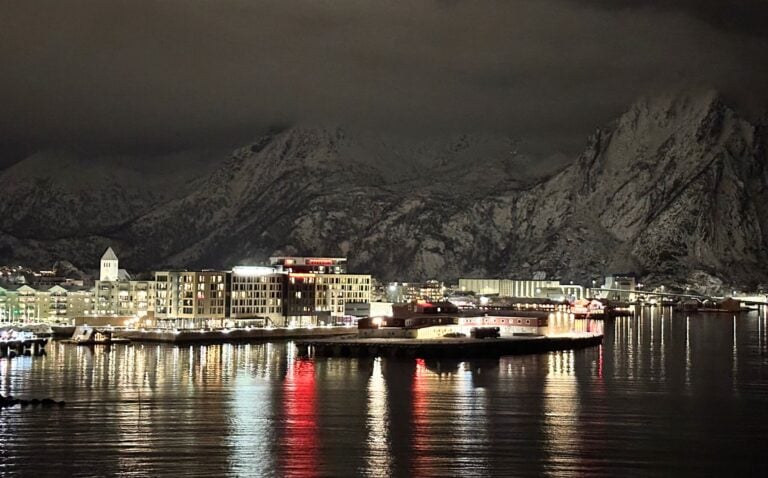
The town is well-equipped for visitors, with a wide range of accommodation to suit all budgets and travel styles.
Several well-known hotel chains operate here, including Thon Hotel Lofoten, which enjoys a harbourfront location and is popular with cruise passengers, and Scandic Svolvær, which offers waterfront views and a cosy restaurant featuring local cuisine.
For those travelling on a tighter budget, there are now several mid-range and budget-friendly hotels and guesthouses, as well as hostel-style options catering to hikers and backpackers. In recent years, a number of smaller, locally run lodges and boutique stays have also popped up, offering more intimate and affordable alternatives.
If you’re looking for a more rustic or traditional Norwegian experience, consider renting a rorbu, which is a restored fisherman’s cabin.
These are scattered along the waterfront in and around Svolvær and offer a charming and atmospheric stay, often with views over the harbour or surrounding peaks. Many are equipped with kitchens, making them ideal for longer stays or travellers who prefer to self-cater.
Wherever you stay, Svolvær’s compact size means you’ll never be far from the boat tours to Trollfjord, the art galleries and seafood restaurants, or the scenic hiking trails that begin just beyond the town limits.

